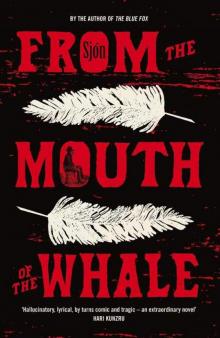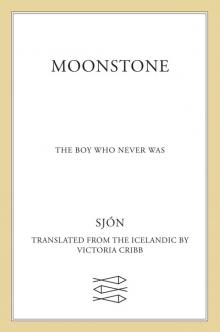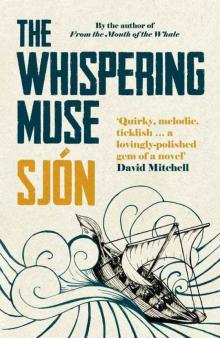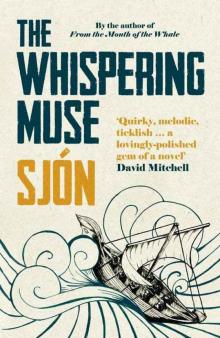Moonstone Read online
Page 6
Finally, Gudbjörn asks if there is anything in particular, apart from his clothes, that Máni Steinn would like them to fetch from the old lady—he calls her by her full name—who will be told that the boy has been given a place on a trawler.
The boy replies that under his pillow is a red scarf that he would be glad to have.
When they are leaving, the shadow of the door falls on the fourth man just as he turns back and calls out:
—But, but, shouldn’t he, shouldn’t we…?
And then the boy recognizes the voice of the man who wanted to “put him out of his misery,” who is none other than the shifty gentleman he sucked off on the slope of Öskjuhlíd the night the Katla eruption began.
He smiles at the man. That shuts him up.
* * *
The boy lies down on the sofa and in no time he is asleep.
He dreams of antelopes.
xxvii
—Máni, Máni Steinn …
The boy feels a touch on his shoulder:
—Máni …
Sóla G— is kneeling beside the sofa.
* * *
They emerge from the clinic where the boy has been held and he discovers that he’s in the largest building he has ever entered. A whitewashed corridor; black-varnished doors on either side as far as the eye can see; a ceiling three times the normal height; highly polished linoleum; and great spherical ceiling lights that recede in a row down the corridor like a fading echo.
Máni Steinn feels an urge to shout.
The staircase alone would make an impressive structure. As if hewn from rock, the steps descend and vanish into the darkness of the lower floors. And from the wide stairwell rises a tower of wrought iron: the elevator shaft.
Sóla G— is at home here. Her father’s office is on the first floor. She presses a button beside the elevator doors.
A clank is heard from the top of the shaft.
The mechanism comes to life and with a reassuring hum begins to drag the elevator up to where they are standing.
* * *
Sóla G— lends the boy her hand and helps him out of a window on the top floor of the huge Nathan & Olsen building. It is pitch-dark.
—Stay close to me.
The boy picks his way after the girl’s silhouette, first along a walkway above the eaves, then diagonally up the sloping roof until they reach the top. His head swims, and Sóla G— tells him to straddle the ridge. Seated like this, he shuffles after her to the tower, where she helps him to his feet.
—I thought you might like to see this before you leave.
From the roof of the largest building ever constructed in Iceland—it is a whole six stories high—there is a view north to the Snæfellsjökull Glacier and south to the Reykjanes Peninsula with the pyramid form of Mount Keilir.
There is a view of Reykjavík too, darkened by the shortages—the houses look like the lumps of coal that people can only dream of.
Máni Steinn gazes out at the spit of Laugarnes, the only place in town left untouched by the epidemic, and suddenly the thought strikes him that before he and Sóla G— say goodbye for the last time there is something he must tell her about himself.
He points to an imposing wooden building on the spit.
—That’s where I lived for the first year after I came to town.
The girl is thrown.
—At the Leper Hospital?
* * *
The freighter Sterling is lying at anchor in the harbor.
Two passengers are to leave with her at dawn.
The boy is one. The other is an Englishman, who for more than a month has been waiting out the Spanish flu at the Merchant’s House in the village of Eyrarbakki on the south coast. And he’s surprisingly kind for a peg leg—as the old lady would put it—since he has agreed to escort the boy to London.
There he will be received by an Icelander who knows all the ropes—the playwright Haraldur Hamar.
Máni Steinn laughs; black wings beat wildly in his breast.
X
(July 9, 1929)
xxviii
There is a cosmopolitan air to the group who appear at the telegram counter of the Reykjavík Post Office one July afternoon in 1929.
These are the trio associated with the Pool Group—the director Kenneth Macpherson, the poet Robert Herring, and the novelist Annie Winifred Ellerman, who has adopted the pen name of Bryher—and M. Peter Carlson, their assistant and interpreter on their Icelandic tour. The purpose of their visit to the country is to record footage for an experimental film.
Shortly before leaving England they held a screening in an art gallery of their second short film, Monkeys’ Moon, and celebrated the first issue of the fourth year of their cinema journal, Close Up, published and edited by Macpherson and Bryher, to which Herring has from the outset been one of the key contributors. The journal proclaims itself the first in the world to treat cinema as a fine art that calls for experimentation and psychological inquiry. It also crusades against censorship of all kinds.
Like their friends in the French surrealist movement, the group is fascinated by Freud’s theories and methods. They believe that with focused and audacious cinematography—scratching and drawing directly onto film, irrational montages, superimposition, changes of speed, close-ups of objects and body parts, intercuts between images of animals and people, the subversion of a linear plot—it is possible to re-create the complex life of the unconscious and free the individual from obsolete ethical norms and psychological inhibitions.
Their goal is the psychoanalysis of the masses and the liberation of society through film.
Two of the foursome enjoy a permissive lifestyle that would be unthinkable to the inhabitants of the country they are visiting, not because they live a life of luxury courtesy of Bryher’s vast fortune—she is the daughter of the shipping magnate John Ellerman, the wealthiest man in the history of Britain, lives in an exclusive villa in Switzerland’s Montreux, and is a patron of artists from all over Europe—nor because they move in a world where friendships can be destroyed by a difference of opinion about a minute-long close-up or a single word in a poem, but because Bryher and Macpherson entered into their marriage solely in order to adopt the daughter of Hilda Doolittle, a.k.a. H.D., the American poet and member of Pool, with whom both are having an affair.
The telegram assistant cannot guess from the appearance or behavior of the group that they are experimentalists in more than just literature and film. Macpherson’s and Herring’s vivacity doesn’t strike him as the slightest bit odd—after all, high spirits are perfectly normal in those who have just disembarked in a new country; his attention is mainly drawn to Bryher’s short hair, since his own girlfriend has been talking about getting a bob.
The group’s reason for visiting the telephone exchange is for Bryher to send a wire to H.D.—due to a crise de nerfs, she has not come with them to Iceland but remained at home in London in her flat on Sloane Street—for so passionate is their love that they write to each other daily when parted by land or sea.
Carlson makes the arrangements and waits while Bryher reads the message to the pop-eyed assistant:
“DEAR CAT—STOP—SAFE IN THULE—STOP—LOVE FIDO”
Once they have emerged from the post office, Carlson asks his traveling companions to excuse him because he is still unsteady on his legs after their voyage around the cape of Reykjanes and he doesn’t feel up to attending afternoon tea with Snæbjörn Jónsson, owner of the English Bookshop, and his wife, A. Florence Westcott. Before he takes leave of the trio, they agree to meet first thing the next day in the saloon of the S.S. Arcadian.
They will be leaving port early on this large cruise liner, which literary types like to call Pan after the most famous of Arcadia’s sons.
The footage the Pool Group have come to Iceland to shoot is to include seals, and they are hoping to find some up north.
xxix
Shortly after the locals and their guests have sat down to dinner, M. P
eter Carlson walks through the cemetery gate on the corner of Sudurgata and Sólvallagata. At the top of the slope are the graves of those who died in the Spanish flu.
The rowan saplings planted in 1919 have grown tall.
Their flowers light up the evening like a myriad white suns.
* * *
A little farther to the west Carlson finds the grave he has come to visit. It is marked by a white marble slab, which he’d had engraved in England and sent over to the cemetery:
KARMILLA MARIUSDOTTIR
*JUNE 14, 1833
† SEPTEMBER 6, 1924
REST IN PEACE
He was six years old when he was placed in the care of Karmilla Maríusdóttir. Whether she was his only living relative or the only one who dared to take him in, he doesn’t know. She was seventy-five, and informed him that she was his great-grandmother’s sister and that he mustn’t expect to be with her for long as she should have been dead years ago.
He had a mother and remembers her as well as it is possible to remember a person one hardly ever saw or touched. He retains no memories of anyone else. If he ever had a father or siblings, a grandfather or grandmother, they are lost. And since the old woman never mentioned them, he never asked.
Yet he has a faint memory of a girl feeding him blueberries. He can sometimes feel the berries on his lips. She could have been his sister—though it’s just as likely that he was never fed blueberries at all.
* * *
The first years of his life were tied to one person and one place:
His mother and the door of her room.
Below the middle of the door was a hatch that opened from the outside. Through it he used to see his mother at mealtimes and “when she was allowed to have him by her.” Then the hatch was left open for a while and the woman used to sit beside it and talk to her child.
He understands now that his mother was already suffering from leprosy when she gave birth to him. By the time he first remembers sitting on the footstool outside the hatch, she had taken to covering her face with a veil and wearing gloves on her hands.
Once, she allowed him to see her. He can still summon up the image of her gentle face as it appeared to him through the bottom of the glass that she asked him to hold to his eye.
* * *
If he did anything else for those first five years apart from sit on that footstool, he cannot say. It was only when he was mounted on a horse and taken away that he saw the farm where they lived for the first time. Once they had crossed the river, he turned in the arms of the man who was holding him and saw the turf-roofed farm at the foot of a high mountain with four peaks.
Their journey ended at the Leper Hospital on Laugarnes.
After a year had passed and it was certain that he had not been infected, he was sent into town to Karmilla Maríusdóttir.
The next thing the old lady said, after predicting her imminent death, was that he must never tell a soul what had happened to his mother and “never, never, never” that he himself had been in the men’s ward at the Leper Hospital.
And he answered:
—But I’m not a man, I’m a child …
xxx
Toward the eastern end of Lindargata, right by Vitatorg Square, there is a two-story house, clad in corrugated iron and painted in bolder colors than any of its neighbors. The roof is black, the side walls and gables purple, the woodwork maroon, and the window mullions white.
A charabanc is parked in the drive leading to a workshop that is decorated in the same colors as the house. The sign painted on its sides reads:
SÓLBORG GUDBJÖRNSDÓTTIR—HOUSE PAINTER
TELEPHONE: 323—FOR DECORATING IN ANY COLOR
Leaning against the workshop wall on the garden side is an old Indian motorcycle—its red varnish peeling, its tires flat—and beside it stands a gleaming Triumph Model Q.
The windows facing the street are at head height and one of them is open. The curtain has been sucked out of it and flaps in the evening breeze. There is the sound of female voices inside.
* * *
M. Peter Carlson walks along the sandy shore in the direction of Laugarnes.
He’s glad he didn’t give in to the temptation to knock on the door of the purple house:
Sóla G— lives on untouched in his memory.
The last few years have been good to him. He trained as an electrician and has had plenty to do assisting lighting technicians and cameramen on films. His job title is Best Boy—in other words, he’s still a boy, though he’s now twenty-seven years old.
He rents a small flat in Chelsea with Richard “Buddy” Williams, a printer of whom he is very fond. Williams produces books of poetry and other slim volumes in small print runs of exceptionally high quality. That is how they became acquainted with the Pool Group, though Carlson had already been aware of their existence and had noticed H.D. at the parties he attended with Haraldur Hamar when he first arrived in England.
Carlson goes to all the films that come to London. Naturally, he has already seen Josef von Sternberg’s Underworld, which is showing at Reykjavík’s Old Cinema this evening. Bryher and Macpherson do not share his enthusiasm for Sternberg’s crime pictures—they prefer the psychological dramas of G. W. Pabst—but he recognizes the debt Sternberg owes to Feuillade’s Les Vampires and Fantomas, which is filmmaking to his taste.
In the hall of his and Buddy’s flat on Tite Street hangs a sign: BEWARE OF FALLING COCONUTS.
That’s their kind of humor.
* * *
Carlson is only fifty yards short of the Leper Hospital when he experiences a sudden sensation of weightlessness. Glancing at his hands, he discovers that he can see right through them. He gropes for his body and finds that he is clutching at thin air. He can’t feel a thing apart from the wingbeats where his heart used to be.
* * *
A middle-aged man comes around the corner of the hospital. This is Sigurdur Ásgrímsson, a farmer from Dæli on Lake Hópsvatn, who has been a patient here since he fell ill with the disease six years ago.
For an instant he thinks a young man is standing before him, but at the next moment a black butterfly appears, bigger than any he has set eyes on before. It flutters up to him and settles on the stump of the ring finger of his right hand. A thought crosses his mind:
“My Gísli would appreciate this.”
Gísli, the fourth of his seven children, is a boy of thirteen who has been employed on a fishing boat on the island of Málmey ever since the family was broken up.
Neither of them knows that in ten years’ time Gísli will have a son named Sigurdur Ásgrímur, or that his sixth child will be the son Steinólfur Sævar, known all his life as Bósi.
And it will be in memory of Bósi—sailor, alcoholic, booklover, socialist, and gay—who will die of AIDS in the month of May 1993, that Sigurdur Ásgrímur’s eldest son, Sigurjón, will sit down to write the story of Máni Steinn, the boy who never was.
ACKNOWLEDGMENTS
Special thanks are due to A. S. Byatt and Neel Mukherjee for their inspiration and support.
ALSO BY SJÓN
The Whispering Muse
The Blue Fox
From the Mouth of the Whale
A NOTE ABOUT THE AUTHOR
Born in Reykjavik in 1962, Sjón is a celebrated Icelandic novelist. He won the Nordic Council’s Literary Prize (the Nordic countries’ equivalent of the Man Booker Prize) for his novel The Blue Fox, and his novel From the Mouth of the Whale was short-listed for both the International IMPAC Dublin Literary Award and the Independent Foreign Fiction Prize. Also a poet, librettist, and lyricist, he has published nine poetry collections and written four opera librettos, as well as lyrics for various artists. In 2001 he was nominated for an Oscar for his lyrics for the film Dancer in the Dark. Sjón’s novels have been published in thirty-five languages. You can sign up for email updates here.
Thank you for buying this
Farrar, Straus and Giroux ebook.
To
receive special offers, bonus content,
and info on new releases and other great reads,
sign up for our newsletters.
Or visit us online at
us.macmillan.com/newslettersignup
For email updates on the author, click here.
CONTENTS
Title Page
Copyright Notice
Epigraph
Part I
Chapter i
Chapter ii
Chapter iii
Part II
Chapter iv
Chapter v
Chapter vi
Part III
Chapter vii
Chapter viii
Chapter ix
Part IV
Chapter x
Chapter xi
Chapter xii
Part V
Chapter xiii
Chapter xiv
Chapter xv
Part VI
Chapter xvi
Chapter xvii
Chapter xviii
Part VII
Chapter xix
Chapter xx
Chapter xxi
Part VIII
Chapter xxii
Chapter xxiii
Chapter xxiv
Part IX
Chapter xxv
Chapter xxvi
Chapter xxvii
Part X
Chapter xxviii
Chapter xxix
Chapter xxx
Acknowledgments
Also by Sjón
A Note About the Author
Permissions Acknowledgments
Copyright
PERMISSIONS ACKNOWLEDGMENTS
Epigraph: Translation of Robert Desnos’s poem “À la mystérieuse” (“To the One of Mystery”), 1926, by Bill Zavatsky.

 The Blue Fox: A Novel
The Blue Fox: A Novel From the Mouth of the Whale
From the Mouth of the Whale The Dark Blue Winter Overcoat and Other Stories from the North
The Dark Blue Winter Overcoat and Other Stories from the North Moonstone
Moonstone CoDex 1962
CoDex 1962 The Whispering Muse: A Novel
The Whispering Muse: A Novel The Whispering Muse
The Whispering Muse The Blue Fox
The Blue Fox